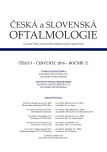Orbital Exenteration in Patient with Metastatic Choroidal Melanoma – a Case Report
Authors:
P. Justusová; M. Štubňa; M. Veselovský; B. Lipková
Authors‘ workplace:
Očné oddelenie, FNsP Žilina, primár MUDr. Michal Štubňa, PhD.
Published in:
Čes. a slov. Oftal., 72, 2016, No. 3, p. 92-96
Category:
Case Report
Overview
Introduction:
Uveal melanoma is the most common primary intraocular tumour in adults in Caucasians and in 75% is arising from choroid. It threatens not only the patient’s loss of vision and eye, but also 50% of patients after 5-year interval after therapy die due to distant metastases. The treatment of small and medium-sized melanoma are methods preserving eye globe. Almost half of the total number of patients is still unavoidable enucleation. Considerably rarer is indicated exenteration of an orbit. These tumors metastasize only hematogenous, while the most frequent place of localization of distant metastases is the liver. Generalized disease prognosis is poor, and our current treatment options in this stage are ineffective.
Material and methods:
Case report of 59 years old patient with choroidal melanoma stage T4 N1 M1 massively infiltrating the orbit. At the time of diagnosis of the primary tumor distant metastases were present. The patient underwent exenteration of the orbit and systemic chemotherapy.
Discussion:
Although choroidal melanomas with extrascleral extension and infiltration into the orbit have no better prognosis after exenteration of the orbit, surgery is providing us local tumour control. Good cosmetic effect after this mutilating procedure is offered by individually made prosthesis (epithesis). All patients with uveal melanoma require lifelong dispensation, distant metastases may occur even after many years. In the treatment of generalized disease is available systemic chemotherapy and immunotherapy only palliative. The best effect on survival has complete surgical resection of single metastasis. Uveal melanoma has a different genetic profile as cutaneous melanoma. The biological nature of uveal melanoma seems to be the key to determining risk patients, as well as the development of targeted systemic therapy.
Conclusion:
Treatment of patients with generalized large uveal melanoma with extrascleral extension is difficult. A better understanding of biological interest may be the key to the detection of patients at higher risk of distant metastases formation, and to an effective systemic treatment.
Key words:
large uveal melanoma, extrascleral extension, orbital exenteration, the treatment of generalized disease
Sources
1. Albert, D. M., Ryan, L. M., Borden, E. C.: Metastatic ocular and cutaneous melanoma: a comparision of patient characteristics and prognosis. In Arch Ophthalmol, 1996; 114(1): 107.
2. Baráková, D., et al.: Nádory oka, Grada Avicenum, Praha, 2002, 152 s.
3. Bianco, G: Diagnosis and treatment of orbital invasion in uveal melanoma. Can J Ophthalmol, 2004; 39: 388–396.
4. Bowling, B.: Kanski´s Clinical Ophthalmology, 8th edition. Elsevier, 2016, 917 p.
5. Damato, B., Singh, A. D.: Clinical Ophthalmic Oncology, Uveal Tumours, 2. vydanie. Springer, 2014, 382 p.
6. Field, M. G., Decatur, C. R., Kurtenbach, S.: PRAME as an Independent Biomarker for Metastasis in Uveal Melanoma. Clinical Cancer Research. 2016; 22(5): 1234–42.
7. Fournier, G. A., Albert, D. M., Arrigg, C. A., et al.: Resection of solitary metastasis. Approach to palliative treatment of hepatic involvement with choroidal melanoma. Arch Ophthalmol, 1984; 102(1): 80.
8. Frenkel, S., Nir, I., Hendler, K., et al.: Long-term survival of uveal melanoma patients after surgery for liver metastases. Bri J Ophthalmol, 2009; 39(8): 1042.
9. Furdová, A.: Extrasklerálne prerastanie malígneho melanómu choroidey po endoresekcii. Čes a slov Oftalmol, 2012(4): 163–168.
10. Furdová, A., Ferková, A., Krásnik, V., et al.: Exenterácia očnice pre malígny melanóm choroidey v štádiu T4; možnosti epitetického riešenia. Čes a slov Oftalmol, 2015(3): 150–156.
11. Furdová, A., Chynoranský, M., Krajčová, P.: Orbital melanoma. Bratislava Medical Journal – BLL. 2011; 112 (8): 466-468.
12. Furdová, A., Strmeň, P., Šramka, M.: Complications in patients with uveal melanoma after stereotactic radiosurgery and brachytherapy. In Bratislava Medical Journal – BLL. 2005, 106(12): 401-406.
13. Furdová, A., Oláh, Z.: Malígny melanóm v uveálnom trakte. Bratislava, Asklepios, 2002, 172 s.
14. Furdová, A., Oláh, Z.: Nádory oka a okolitých štruktúr. Brno, CERM, 2010, 152 s.
15. Furdová, A., Šramka, M.: Uveal malignant melanoma and stereotactic radiosurgery. Saarbrucken: LAP LAMBERT Academic Publishing, 2014, 181 s.
16. Furdová, A., Šramka, M., Waczulíková, I.: Stereotaktická rádiochirurgia (LINAC) uveálnych melanómov; postradiačné komplikácie. Čes a slov Oftalmol, 2015; (3): 134-142.
17. Hodi, F. S., O´Day, S. J., McDermott, D. F., et al.: Improved survival with ipilimumab in patients with metastatic melanoma. New England Med, 2010; 363(8): 711.
18. Onken, M. D., Worley, L. A., Long, M. D., et al.: Oncogenic mutations in GNAQ occur early in uveal melanoma. Invest Ophthalmol Vis Sci, 2008; 49(12): 5230.
19. Migliori, M. E.: Enucleation, Evisceration and Exenteration. In Albert & Jakobiec´s Principles & Practice of Ophthalmology. Philadelphia, Elsevier, 2008, 3519–28.
20. Nathan, P., Cohen, V., Coupland, S., et al.: Uveal Melanoma UK National Guidelines. Eur J Cancer, 2015; 51(16): 2404–12.
21. Perry, J. D., Singh, A. D.: Clinical Ophthalmic Oncology, Orbital Tumours. Berlin, Springer, 2014, 221 p.
22. Pfohler, C., Cree, I. A., Ugurel, S. et al.: Treosulfan and gemcitabine in metastatic uveal melanoma patients: results of a multicenter feasibility study. Anticancer drugs, 2003; 14(5): 337.
23. Van Raamsdonk, C. D., Griewank, K. G., Crosby, M. B. et al.: Mutations in GNA11 in uveal melanoma. New England Med, 2010; 363(23): 2191.
Labels
OphthalmologyArticle was published in
Czech and Slovak Ophthalmology

2016 Issue 3
Most read in this issue
- Outcomes of Trifocal Toric Lens Implantation in Cataract Patients
- Local Rotating Flaps in Oculoplastic Surgery
- First Experience with Femtosecond Laser Presbyopia Correction Method INTRACOR
- Objective Assessment of Postoperative Results of Intraocular Lenses
